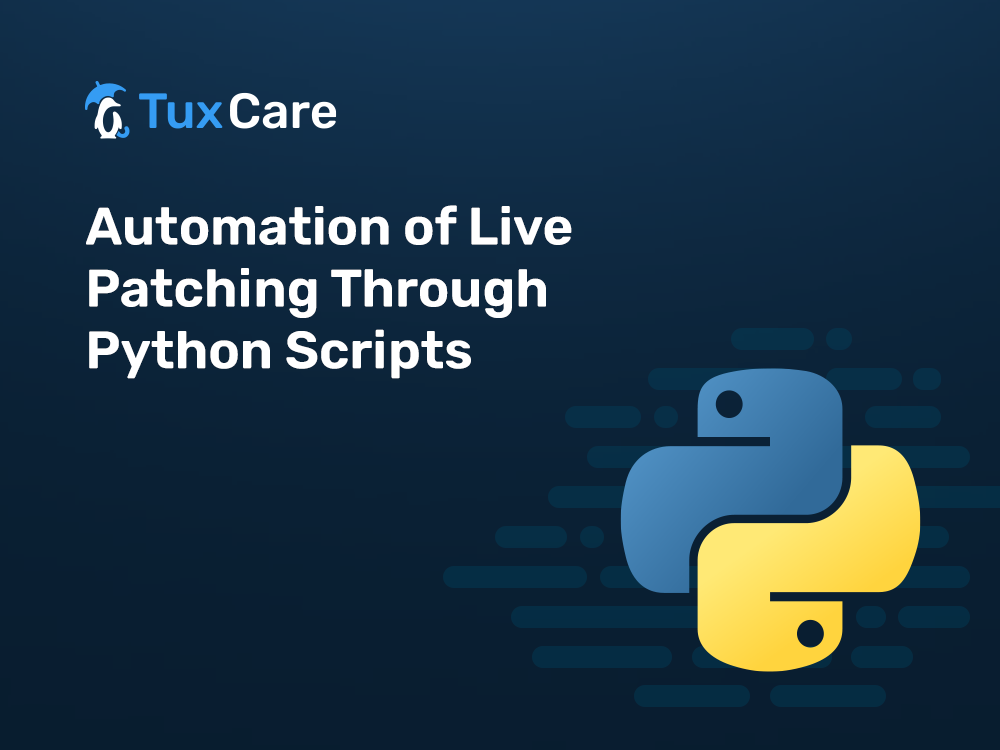Automation of Live Patching through Python Scripts
As one of the most popular scripting languages for a variety of applications, Python also offers incredibly valuable functionality when it comes to automated live patching – a modern approach to vulnerability patching that takes reboots and downtime out of the equation.
In this blog post, you’ll discover how automated live patching reduces risk and how Python can play a critical role in adopting this patching approach.
Automation with Python
Python has consistently retained its popularity among developers because of its versatility and ease of use. Many software packages use it, including web development, game development, scientific computing, and even robotics. With so many benefits, it’s easy to see why Python is so popular.
For example, Python is a good option if you’re looking for an easy way to automate your workflow within the Unreal Engine editor. It’s easy to learn, has many useful libraries, and allows you to create complex user interfaces using PySide. There are many other free functional options out there too.
Reducing Risk with Automated Live Patching
Large enterprises face challenges when trying to keep their systems secure. According to Ponemon, 56 percent of these organizations spend between five weeks and one-year applying security updates. Meanwhile, high-risk vulnerabilities continue to show up unexpectedly.
Most organizations settle for monthly or quarterly maintenance cycles, where they update their software, services, and servers. These time-consuming processes ensure the installation of the latest security updates, but at the expense of downtime and, most notably, at the cost of wasting valuable resources on mundane tasks.
Before going into manual Linux updates, administrators should know how simultaneously delicate and inefficient they are. Mistakes during installation could easily cause severe problems. Time-consuming manual updates could take hours or days, depending on the number of changes needed. It’s also tedious to update when multiple updates are required.
A more efficient approach is automated live patching, which enables teams to deploy patches automatically without needing to reboot or take systems out of production. Live patch management without rebooting allows you to patch your system immediately after a patch has been released instead of waiting for the next scheduled maintenance period.
Simplifying Linux Kernel OS Live Patching Across Several Locations
Python automation empowers DevOps and SecOps with the ability to patch several assets within one work sprint. Patching a Linux OS kernel is an excellent example of leveraging a Python script for a simplified security updates sprint.
Linux OS hosts could exist in several places within the client’s enterprise environment:
- Docker containers
- Linux Hosts Running inside of AWS, Google, or Azure
- Libraries within GitHub
- QA, Dev, and Staging platforms
- Closed-Loop Air-Gapped networks
With a single python automated script, SecOps and DevOps teams can rapidly deploy patches to stop zero-day vulnerabilities and ransomware propagation attacks or apply vetted live patches across the organizational digital landscape.
Extending Python Automation Patching Across Several Domains
Deploying Live Patching tools to several hosts is a proven and effective strategy with Python scripting. Organizations can extend this capability by updating several devices and hosts within a digital transformation strategy portfolio regardless if they are on-premises, embedded within cloud platforms, or hosted by an IaaS provider.
For transformations to deliver their expected results, security operations as well as ongoing rapid deployment of updates and code releases are critical.
Python automation scripts will extend this capability into updating all components supporting the transformation strategy. Most transformation strategies are comprised of devices, applications, and cloud locations.
Within this new architecture, the platform could be a combination of the following features:
- Linux OS Hosts
- IIoT Devices
- Windows Servers
- Open Source Databases
- Legacy Python and PHP applications
- Advanced NGFW Technology
- Zero-Trust Access Control
- Advanced AI and ML Platforms
Patching the entire transformation architecture will ensure several critical benefits:
- Meeting compliance requirements as well as enabling data governance and risk reduction across the whole transformation platform
- Joint updates to all components within the transformation platform
- Ensuring all patches and security updates load correctly between inter-operating devices
- Ensuring the highest degree of cyber protection across the transformation architecture with minimal human interaction or errors
Automating Vulnerability Patching with TuxCare
With vulnerability patching solutions from TuxCare, leaving your systems exposed for too long is one less automation-related risk you need to worry about. TuxCare’s automated vulnerability patching solution, KernelCare Enterprise, integrated into a Python script enables you to deploy the latest Linux vulnerability patches without reboots automatically.
KernelCare protects your Linux systems by rapidly eliminating vulnerabilities without you needing to wait for maintenance windows or downtime. With TuxCare, IT teams can automate taking new patches through staging, testing, and production on all popular Linux distributions.
TuxCare features flawless interoperability with vulnerability scanners, security sensors, and automation tools, as well as integration with vulnerability management processes, reporting tools, and our ePortal patch deployment management platform – a dedicated private patch server that runs inside your firewall on-premises or in the cloud.
TuxCare is the only provider that can live patch security vulnerabilities in kernels, shared libraries, virtualization platforms, and open-source databases across all popular distributions.
Want to learn more about TuxCare’s live patching technology and how it can generate operational efficiencies for your team?



 Documentation
Documentation Login
Login



